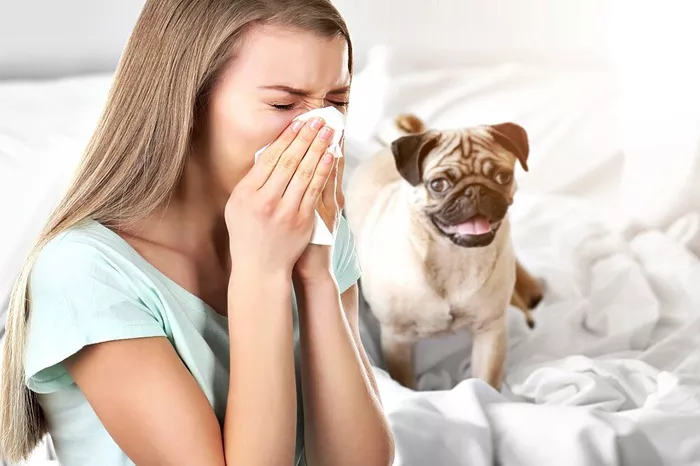Pet allergies are a common concern among individuals, particularly those who have a furry friend at home. While pets can bring immense joy and companionship, they may also trigger allergic reactions in susceptible individuals. Understanding the symptoms of pet allergies is crucial for effective management and improving overall quality of life. In this comprehensive guide, we delve into the various symptoms associated with pet allergies, their causes, and strategies for alleviating discomfort.
Pet Allergies
Pet allergies arise when the immune system reacts abnormally to proteins found in the skin cells, saliva, or urine of animals. The primary allergens are proteins produced by glands in the animal’s skin (dander), as well as proteins in their saliva and urine. Contrary to popular belief, pet hair itself is not the allergen; rather, it acts as a carrier for these proteins. When individuals with allergies come into contact with these allergens, their immune system perceives them as harmful invaders, triggering an allergic response.
Common Symptoms of Pet Allergies
Pet allergy symptoms can vary widely among individuals and may range from mild to severe. Here are some of the most common symptoms associated with pet allergies:
Respiratory Symptoms
Sneezing: One of the hallmark symptoms of pet allergies is frequent sneezing, often occurring shortly after exposure to the allergen.
Runny or Stuffy Nose: Individuals with pet allergies may experience a runny or congested nose, accompanied by clear nasal discharge.
Coughing: Persistent coughing may occur, particularly in individuals with underlying respiratory conditions such as asthma.
Wheezing: Some individuals may experience wheezing or difficulty breathing, especially if they have asthma triggered by pet allergens.
Shortness of Breath: Severe allergic reactions can lead to shortness of breath or chest tightness, requiring immediate medical attention.
Skin Symptoms
Itchy, Watery Eyes: Pet allergies commonly manifest as itchy, watery eyes, also known as allergic conjunctivitis.
Skin Rash or Hives: Direct contact with pet allergens may result in a skin rash or hives, characterized by redness, swelling, and itching.
Eczema Flare-ups: Individuals with eczema may experience exacerbation of symptoms upon exposure to pet allergens, leading to increased itching and inflammation.
Other Symptoms
Fatigue: Allergic reactions, particularly when persistent, can lead to fatigue and general malaise.
Headaches: Some individuals may experience headaches as a result of exposure to pet allergens, especially if they have underlying allergies or sensitivities.
Sinus Pressure: Allergic reactions to pet allergens may cause sinus pressure or facial pain, particularly around the forehead, cheeks, and eyes.
Identifying Triggers and Allergy Testing
Identifying specific pet allergens and triggers is essential for effective management of pet allergies. Allergy testing, conducted by a healthcare professional, can help pinpoint the exact substances to which an individual is allergic. Common allergy testing methods include skin prick tests and blood tests (specifically measuring IgE antibodies). Additionally, keeping a symptom diary can help individuals track their exposure to pet allergens and identify patterns of symptoms.
Understanding Cross-Reactivity
It’s important to note that individuals allergic to one type of pet may also experience allergic reactions to other animals. This phenomenon, known as cross-reactivity, occurs when the immune system recognizes similar proteins in different species. For example, individuals allergic to cats may also experience symptoms when exposed to dogs or other furry animals. Understanding cross-reactivity can help individuals make informed decisions when selecting pets and managing their allergies.
Managing Pet Allergies
While complete avoidance of pet allergens may be challenging, several strategies can help individuals manage their symptoms effectively:
Pet-Free Zones
Designating certain areas of the home as “pet-free zones,” such as bedrooms or living spaces, can minimize exposure to allergens, providing a refuge for allergic individuals.
Regular Cleaning
Frequent cleaning of the home, including vacuuming carpets, washing bedding, and dusting surfaces, can help reduce the concentration of pet allergens indoors.
Air Purification
Using high-efficiency particulate air (HEPA) filters in HVAC systems and air purifiers can help remove pet allergens from the air, improving indoor air quality.
Pet Grooming
Regular grooming and bathing of pets can help reduce the amount of dander and allergens present on their fur, potentially mitigating allergic reactions in sensitive individuals.
Medications
Over-the-counter or prescription medications, such as antihistamines, nasal corticosteroids, and decongestants, can help alleviate symptoms of pet allergies. Immunotherapy (allergy shots) may also be recommended for individuals with severe or persistent symptoms.
Conclusion
Pet allergies can significantly impact an individual’s quality of life, but with proper understanding and management, allergic reactions can be minimized. By recognizing the symptoms of pet allergies, identifying triggers, and implementing effective strategies for control, allergic individuals can continue to enjoy the companionship of their pets while minimizing discomfort and allergic reactions. Consultation with a healthcare professional is recommended for proper diagnosis and personalized management of pet allergies.
[inline_related_posts title=”You Might Be Interested In” title_align=”left” style=”list” number=”6″ align=”none” ids=”5961,5919,5917″ by=”categories” orderby=”rand” order=”DESC” hide_thumb=”no” thumb_right=”no” views=”no” date=”yes” grid_columns=”2″ post_type=”” tax=””]

































